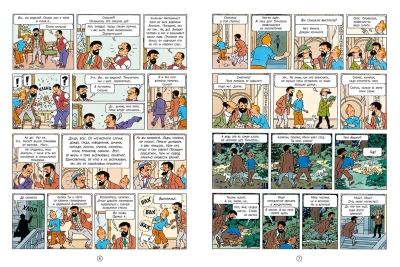The Tournesol Affair
24.99 €
In stock
One evening something strange begins to happen in Mulensar - out of the blue, window panes, mirrors, vases, chandeliers burst and explode into small pieces... Trying to understand what is going on, Tintin notices that all the episodes with exploding glass happen when Tournesol is in his laboratory. And it's true: as soon as the professor left for Geneva to attend a congress on nuclear physics, everything stopped at once! Well, and the boxes full of broken glass found in Tournesol's laboratory only confirmed this conjecture. Worse: after a visit to the lab, it becomes obvious to Tintin and Captain Haddock that someone is very interested in their friend's scientific developments. Wasting no time, they fly to Geneva to warn the professor of the danger....
After three consecutive dilogies ("Pirate", "Inca" and "Moon"), work on which took more than 10 years, Hergé returned to the format of a single-volume story, which has not changed. The publication of the 18th volume of "The Adventures of Tintin" began in December 1954 in the magazine Tintin and lasted more than a year, until February 1956 (the same year the album version was published). The growth of international tensions could not but affect the thoughts and moods of the author, so the appearance of spy themes in the story seems quite natural: it is not without reason that many critics call "The Turnesol Affair" the most cinematic album of the series, comparing it to the films of A. Hitchcock and C. Reed. However, Hergé in no way set himself the task of creating a spy thriller in the spirit of "The 39 Steps" or "The Man Who Knew Too Much", so saturated the next volume with a fair share of humor, which relates him not so much to Hitchcock as to B. Wilder. Strange as it may seem, this very volume, which in terms of plot is hardly the most tense volume of the series, simultaneously became one of the funniest: the book is literally full of gags, both visual (what is the "big trip of the leukoplasty" alone!) and textual (let's remember at least the fairy monologue of the chief of police of the curbside airport). A curious fact: "The Turnesol Affair" is one of the few Tintin adventures (complete, not including the first volumes of the dilogies) in which the hero does not leave the limits of continental Europe.
After three consecutive dilogies ("Pirate", "Inca" and "Moon"), work on which took more than 10 years, Hergé returned to the format of a single-volume story, which has not changed. The publication of the 18th volume of "The Adventures of Tintin" began in December 1954 in the magazine Tintin and lasted more than a year, until February 1956 (the same year the album version was published). The growth of international tensions could not but affect the thoughts and moods of the author, so the appearance of spy themes in the story seems quite natural: it is not without reason that many critics call "The Turnesol Affair" the most cinematic album of the series, comparing it to the films of A. Hitchcock and C. Reed. However, Hergé in no way set himself the task of creating a spy thriller in the spirit of "The 39 Steps" or "The Man Who Knew Too Much", so saturated the next volume with a fair share of humor, which relates him not so much to Hitchcock as to B. Wilder. Strange as it may seem, this very volume, which in terms of plot is hardly the most tense volume of the series, simultaneously became one of the funniest: the book is literally full of gags, both visual (what is the "big trip of the leukoplasty" alone!) and textual (let's remember at least the fairy monologue of the chief of police of the curbside airport). A curious fact: "The Turnesol Affair" is one of the few Tintin adventures (complete, not including the first volumes of the dilogies) in which the hero does not leave the limits of continental Europe.
See also:
- All books by the publisher
- All books by the author
- All books in the series The Adventures of Tintin











